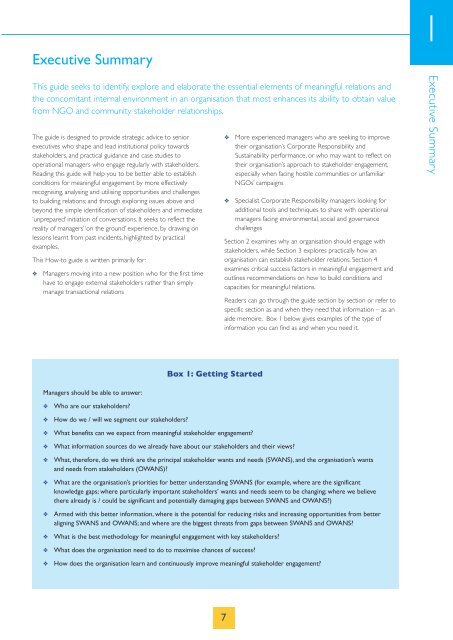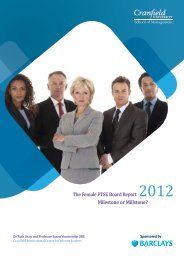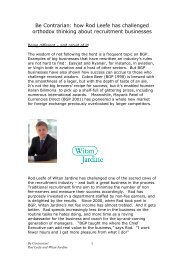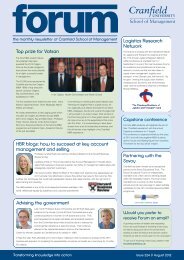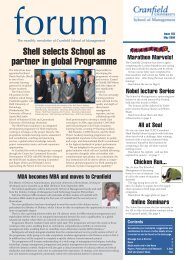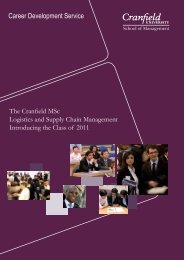Stakeholder Engagement - Cranfield School of Management ...
Stakeholder Engagement - Cranfield School of Management ...
Stakeholder Engagement - Cranfield School of Management ...
You also want an ePaper? Increase the reach of your titles
YUMPU automatically turns print PDFs into web optimized ePapers that Google loves.
Executive Summary<br />
This guide seeks to identify, explore and elaborate the essential elements <strong>of</strong> meaningful relations and<br />
the concomitant internal environment in an organisation that most enhances its ability to obtain value<br />
from NGO and community stakeholder relationships.<br />
The guide is designed to provide strategic advice to senior<br />
executives who shape and lead institutional policy towards<br />
stakeholders, and practical guidance and case studies to<br />
operational managers who engage regularly with stakeholders.<br />
Reading this guide will help you to be better able to establish<br />
conditions for meaningful engagement by more effectively<br />
recognising, analysing and utilising opportunities and challenges<br />
to building relations; and through exploring issues above and<br />
beyond the simple identification <strong>of</strong> stakeholders and immediate<br />
‘unprepared’ initiation <strong>of</strong> conversations. It seeks to reflect the<br />
reality <strong>of</strong> managers’‘on the ground’ experience, by drawing on<br />
lessons learnt from past incidents, highlighted by practical<br />
examples.<br />
This How-to guide is written primarily for:<br />
❖ Managers moving into a new position who for the first time<br />
have to engage external stakeholders rather than simply<br />
manage transactional relations<br />
Managers should be able to answer:<br />
❖ Who are our stakeholders?<br />
❖ How do we / will we segment our stakeholders?<br />
Box 1: Getting Started<br />
❖ What benefits can we expect from meaningful stakeholder engagement?<br />
❖ What information sources do we already have about our stakeholders and their views?<br />
7<br />
❖ More experienced managers who are seeking to improve<br />
their organisation’s Corporate Responsibility and<br />
Sustainability performance, or who may want to reflect on<br />
their organisation’s approach to stakeholder engagement,<br />
especially when facing hostile communities or unfamiliar<br />
NGOs’ campaigns<br />
❖ Specialist Corporate Responsibility managers looking for<br />
additional tools and techniques to share with operational<br />
managers facing environmental, social and governance<br />
challenges<br />
Section 2 examines why an organisation should engage with<br />
stakeholders, while Section 3 explores practically how an<br />
organisation can establish stakeholder relations. Section 4<br />
examines critical success factors in meaningful engagement and<br />
outlines recommendations on how to build conditions and<br />
capacities for meaningful relations.<br />
Readers can go through the guide section by section or refer to<br />
specific section as and when they need that information – as an<br />
aide memoire. Box 1 below gives examples <strong>of</strong> the type <strong>of</strong><br />
information you can find as and when you need it.<br />
❖ What, therefore, do we think are the principal stakeholder wants and needs (SWANS), and the organisation’s wants<br />
and needs from stakeholders (OWANS)?<br />
❖ What are the organisation’s priorities for better understanding SWANS (for example, where are the significant<br />
knowledge gaps; where particularly important stakeholders’ wants and needs seem to be changing; where we believe<br />
there already is / could be significant and potentially damaging gaps between SWANS and OWANS?)<br />
❖ Armed with this better information, where is the potential for reducing risks and increasing opportunities from better<br />
aligning SWANS and OWANS; and where are the biggest threats from gaps between SWANS and OWANS?<br />
❖ What is the best methodology for meaningful engagement with key stakeholders?<br />
❖ What does the organisation need to do to maximise chances <strong>of</strong> success?<br />
❖ How does the organisation learn and continuously improve meaningful stakeholder engagement?<br />
1<br />
Executive Summary


